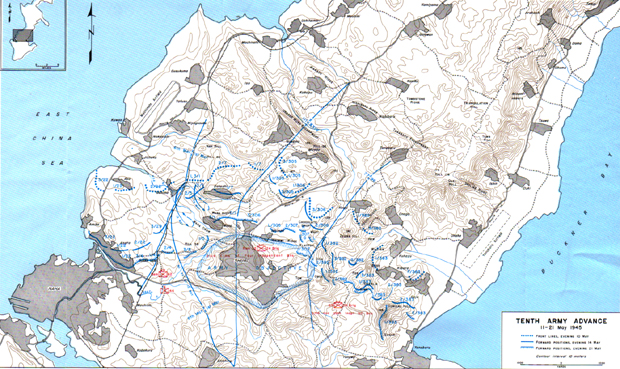On Okinawa, slow American advances and costly Japanese counterattacks continue. Heavy fighting is reported around the Sugar Loaf Hill and Conical Hill positions.
Marines on Sugar Loaf Hill, elements of US 3rd Amphibious Corps, withdraw because of Japanese fire.
The US 1st Marine Division advances along the Wana river valley, west of Shuri, against heavy Japanese resistance.
The US 305th infantry regiment and 77th Divisions, of US 24th Corps, achieve limited progress and have been reduced to 25 percent effectiveness in the fighting.
See Okinawa Map XXXV: Tenth Army Advances, 11-21 May 1945

Campaign Background — Kamikaze!
According Appleman’s OKINAWA:THE LAST BATTLE:
Between 6 April and 22 June there were ten organized (aerial) Kamikaze attacks, employing a total of 1,465 planes as shown below:
Date of Attack…..Total…Navy Planes…..Army Planes
6-7 April……………355…….230…………….125
12-13 April………..185…….125………………60
15-15 April………..165…….120………………45
27-28 April………..115……..65……………….50
3-4 May……………125……..75……………….50
10-11 May………..150……..70……………….80
24-25 May………..165……..65……………..100
27-28 May………..110……..60……………….50
3-7 June…………….50……..20……………….30
21-22 June…………42……..30……………….15
TOTAL
………………………1465………860………………605
In addition, sporadic small-scale suicide attacks were directed against the American fleet by both Army and Navy planes, bringing the total number of suicide sorties during the campaign to 1,900.
This was the model for the resistance to an invasion of the Home Islands.
War history buffs might be interested in this:-
http://www.spectator.co.uk/alexmassie/6001400/tweeting-the-second-world-war.thtml
Michael Kennedy,
Actually, the Japanese KETSU-GO plans were far, far worse than Okinawa’s Kamikaze campaign:
OLYMPIC VS KETSU-GO
Marine Corps Gazette, August 1965, Vol. 49, No. 8.
The greatest danger to the assault was assumed to come from the air. The Americans expected opposition from 5,000 kamikazes, a realistic estimate in keeping with Japanese plans (KETSU-GO Operation). These called for 5,000 planes to be expended in attacks on the invasion force, whose appearance was expected sometime after September. The Japanese estimated that the assault force would be carried in 1,000 transports and that if half were sunk in the first ten days the landings could be smashed. Using the 1:6 ratio derived from their Okinawa experience, Japanese planners estimated this would require 3,000 planes. They assigned an additional 350 kamikazes to attacks on the carrier forces. The remaining 1,650 included those under repair and lost before the attack. As late as 15 July, however, only 70% of the required planes were in hand so it seems reasonable to assume that aerial opposition would have been less than expected.
However, the reality of Japan actually pulling off those plans was very doubtful due to planned American Military countermeasures most professional academics run away screaming from.
Michael Kennedy,
Actually, the Japanese KETSU-GO plans were far, far worse than Okinawa’s Kamikaze campaign:
OLYMPIC VS KETSU-GO
Marine Corps Gazette, August 1965, Vol. 49, No. 8.
The greatest danger to the assault was assumed to come from the air. The Americans expected opposition from 5,000 kamikazes, a realistic estimate in keeping with Japanese plans (KETSU-GO Operation). These called for 5,000 planes to be expended in attacks on the invasion force, whose appearance was expected sometime after September. The Japanese estimated that the assault force would be carried in 1,000 transports and that if half were sunk in the first ten days the landings could be smashed. Using the 1:6 ratio derived from their Okinawa experience, Japanese planners estimated this would require 3,000 planes. They assigned an additional 350 kamikazes to attacks on the carrier forces. The remaining 1,650 included those under repair and lost before the attack. As late as 15 July, however, only 70% of the required planes were in hand so it seems reasonable to assume that aerial opposition would have been less than expected.
However, the reality of Japan actually pulling off those plans was very doubtful due to planned American Military countermeasures most professional academics run away screaming from.